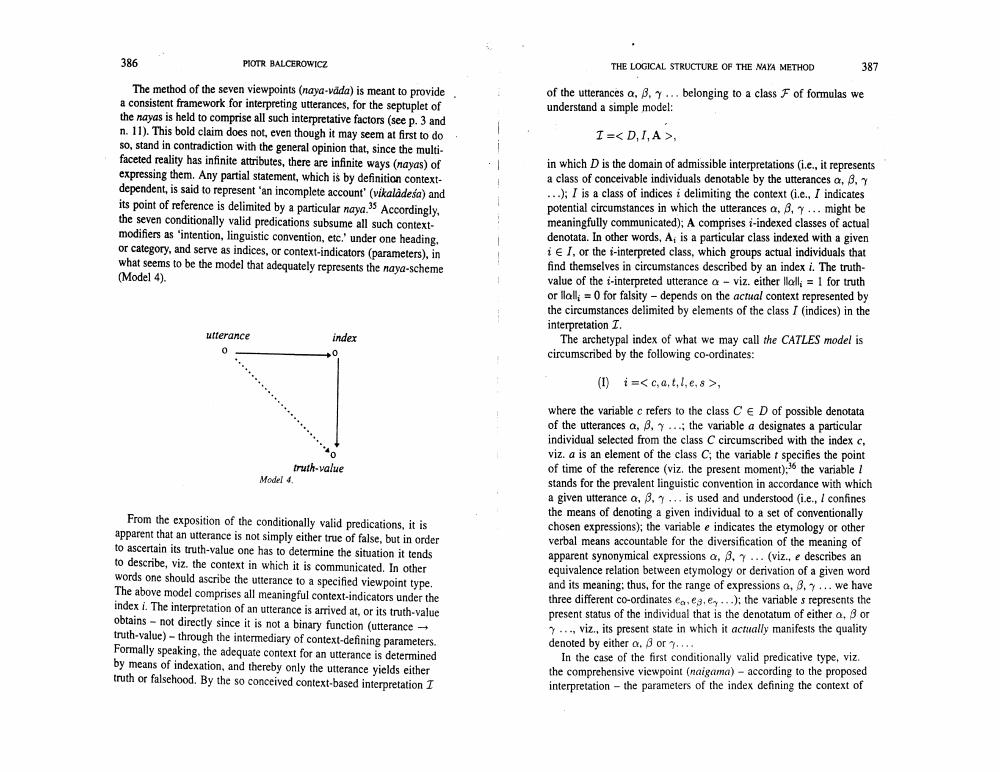Book Title: Logical Structure Of Naya Method Of Jainas Author(s): Piotr Balcerowicz Publisher: Piotr Balcerowicz View full book textPage 5
________________ 386 PIOTR BALCEROWICZ THE LOGICAL STRUCTURE OF THE NAYA METHOD 387 of the utterances a. . ... belonging to a class Fof formulas we understand a simple model: I =<D,1,A> The method of the seven viewpoints (naya.vdda) is meant to provide a consistent framework for interpreting utterances, for the septuplet of the nayas is held to comprise all such interpretative factors (see p. 3 and n. 11). This bold claim does not even though it may seem at first to do so, stand in contradiction with the general opinion that, since the multifaceted reality has infinite attributes, there are infinite ways (nayas) of expressing them. Any partial statement, which is by definition contextdependent, is said to represent an incomplete account' (vikaladeša) and its point of reference is delimited by a particular naya." Accordingly, the seven conditionally valid predications subsume all such context modifiers as 'intention, linguistic convention, etc. under one heading. or category, and serve as indices, or context-indicators (parameters), in what seems to be the model that adequately represents the naya-scheme (Model 4). in which is the domain of admissible interpretations (i.e., it represents a class of conceivable individuals denotable by the utterances a, 8. ....); I is a class of indices i delimiting the context (i.e., I indicates potential circumstances in which the utterances a, 8. y... might be meaningfully communicated): A comprises i-indexed classes of actual denotata. In other words, A, is a particular class indexed with a given iel, or the i-interpreted class, which groups actual individuals that find themselves in circumstances described by an index 1. The truth value of the i-interpreted utterance - viz. either lolli = 1 for truth or llalli = 0 for falsity-depends on the actual context represented by the circumstances delimited by elements of the class I indices) in the interpretation I. The archetypal index of what we may call the CATLES model is circumscribed by the following co-ordinates: utterance inder (1) i =< cat,l.e, 8 >, truth-value Model 4. where the variable c refers to the class C E D of possible denotata of the utterances a, . ..., the variable a designates a particular individual selected from the class C circumscribed with the index c, viza is an element of the class C, the variable i specifies the point of time of the reference (viz. the present moment): the variable ! stands for the prevalent linguistic convention in accordance with which a given utterance a, 3.7... is used and understood (ie., I confines the means of denoting a given individual to a set of conventionally chosen expressions); the variable e indicates the etymology or other verbal means accountable for the diversification of the meaning of apparent synonymical expressions a, 8.7... (viz., e describes an equivalence relation between etymology or derivation of a given word and its meaning: thus, for the range of expressions a, 3.7... we have three different co-ordinates ca.eg.ex...): the variables represents the present status of the individual that is the denotatum of either a 8 or .... viz., its present state in which it actually manifests the quality denoted by either a. or ... In the case of the first conditionally valid predicative type, viz. the comprehensive viewpoint (naigama) - according to the proposed interpretation - the parameters of the index defining the context of sien word From the exposition of the conditionally valid predications, it is apparent that an utterance is not simply either true of false, but in order to ascertain its truth-value one has to determine the situation it tends to describe, viz. the context in which it is communicated. In other words one should ascribe the utterance to a specified viewpoint type. The above model comprises all meaningful context-indicators under the index 1. The interpretation of an utterance is arrived at, or its truth-value obtains - not directly since it is not a binary function (utterance - truth-value)-through the intermediary of context-defining parameters. Formally speaking, the adequate context for an utterance is determined by means of indexation, and thereby only the utterance yields either truth or falsehood. By the so conceived context-based interpretation I sions , .ey.. the individ..Page Navigation
1 ... 3 4 5 6 7 8 9 10 11 12 13
